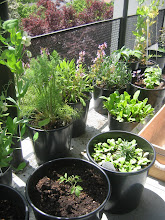I found a baguette pan at goodwill! I saw one about 2 years ago, and had been kicking myself ever since for not buying it. But now I have one, and in my excitement, I had to go look up some recipes for baguette making. I used the smaller formula found here, but I didn't really follow the procedure exactly. Here's what I did:
for the pre-ferment
100g bread flour
100g water
1/2 teaspoon instant yeast
Mix these things together until they are pretty smooth. Cover loosely, and allow to sit at room temperature for 2 to 4 hours. Then either stick it in the fridge until you want to use it, (for me, that was from Friday night until Sunday morning) or start making the bread with it right away.
In either case, add
325g bread flour
155g water
1 1/2 teaspoons salt
1 teaspoon instant yeast
Knead until it's pretty smooth, around 10 minutes, then cover and allow it to rest for 40 min. Fold the dough over on itself 3-4 times, let rest another 40. Do the folds again, and another half hour rest.
After the final rest, gently shape the dough out into a log about 14" long. Cut it in half along the long axis (I used a chef's knife). This will give you 2 long skinny ropes of dough. Pinch the cut edges closed on each one.
Lightly oil the pan, and place each rope of dough in one of the depressions, with the pinched parts facing down.. Cover with a towel and let it rest 10 or 15 minutes.
Brush each baguette with a little water, then slash the tops with a knife.
Bake at 450 for 15 min, then turn the pan and reduce the heat to 375. Bake another 15 minutes.
notes-
1. Measuring ingredients by weight helps a lot. Water is the same size all the time, so you can measure it by volume if you like, but because flour is a compressible powder, a cup of it can contain vastly different actual amounts of stuff. Measuring with a scale eliminates the problem, because a pound of flour is always a pound of flour, no matter how much room it takes up.
2. I used a bread machine. I just set it on the knead cycle for 10 minutes, then took the dough out and put it in a bowl for the resting & folding parts.
3. Today it's pretty cool in my house. I did the rising in the oven, with a kettle of boiled water next to the dough to keep it warm.
4. You shouldn't need to add any more flour for the folding part, and only the lightest dusting on the board for the shaping. Adding a bunch more flour will make the bread heavy and dry.
5. The amount of time it takes to pre-heat my oven is about the right amount of time for the final resting of the dough in the pans. I have an electric oven, so it takes a while.
 6. Don't be afraid to really slash the loaves! I did not do mine quite deeply enough, and as a consequence, the loaves split longitudinally, rather than having those picturesque eyes open in the tops.
6. Don't be afraid to really slash the loaves! I did not do mine quite deeply enough, and as a consequence, the loaves split longitudinally, rather than having those picturesque eyes open in the tops. Man these are great. They also are a giant leap forward in my bread making skills. The pan helps, but I think mostly the procedure is what matters.
There are a couple things about this recipe that seem to be important. One is probably salt. This calls for almost twice what I usually put in my bread. Salt does something to the way yeast metabolizes the flour, but I'm afraid I don't know exactly what. Obviously it also affects taste: this is a very savory loaf, deliciously so.
The other thing is the pre-fermentation of a portion of the dough. Longer rising will times let the yeasts develop more 'bready' rather than 'doughy' flavors in the finished loaf, but letting it go too long will make the dough have a strong alcoholic whiff. That fades quickly, but it still isn't what I want. Rising time also affects texture- long rising gives the best breads a chewy texture, but has a tendency to make them dense and rubbery also. Short rising gives bread a lighter, more delicate texture, but will impart less flavor. The compromise is to pre-ferment only part of the dough. Outcome? Crusty, yet tender,chewy but light, complex taste and freshness together.
Now, how could I have gone and failed to provide myself with some nice runny cheese to go with this? Foolishness! On the other hand, if I had, I would never have realized that a slice of cheddar with a couple nasturtium leaves is a lot like cream cheese and watercress, but with more oomph.









No comments:
Post a Comment